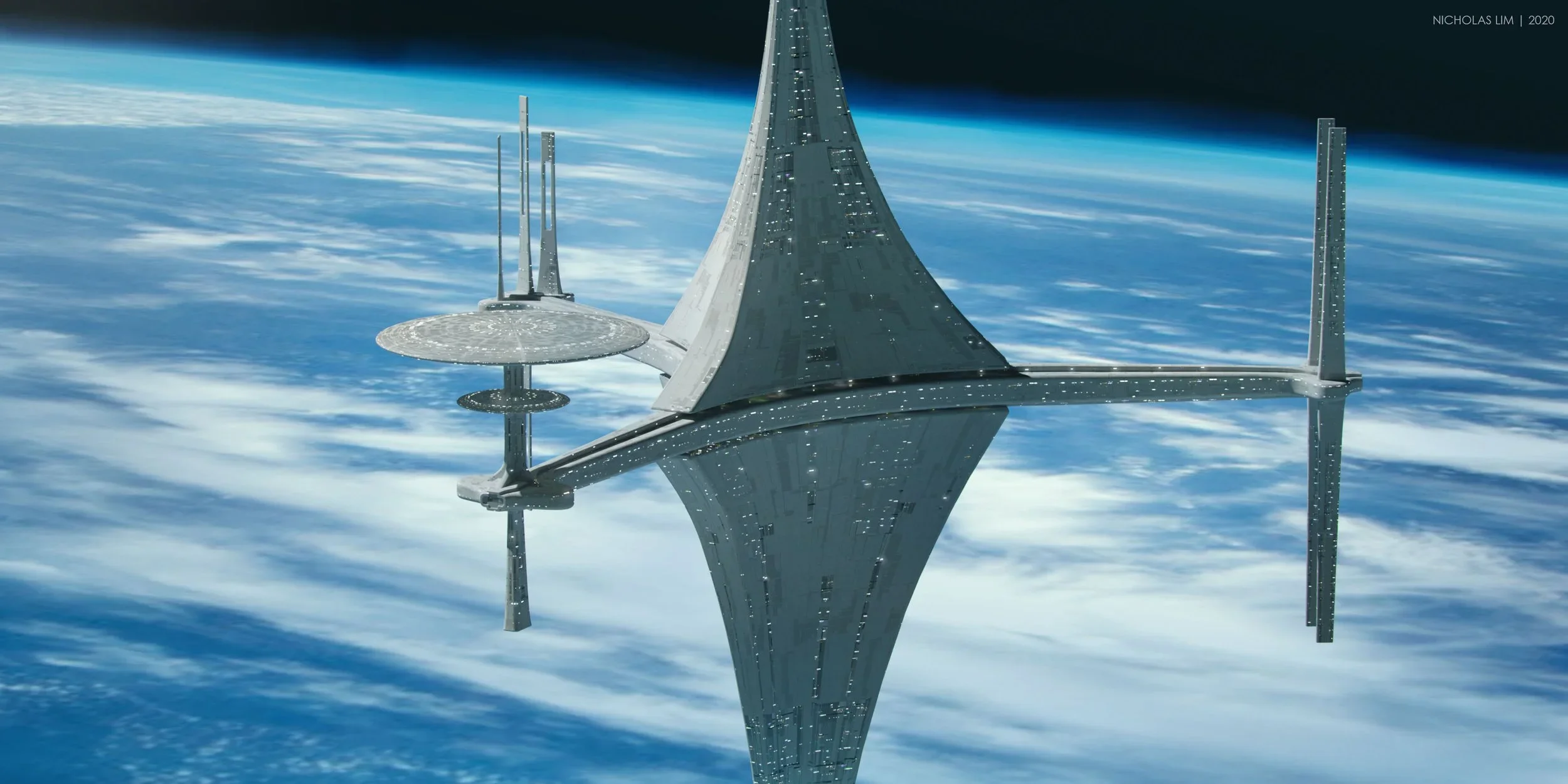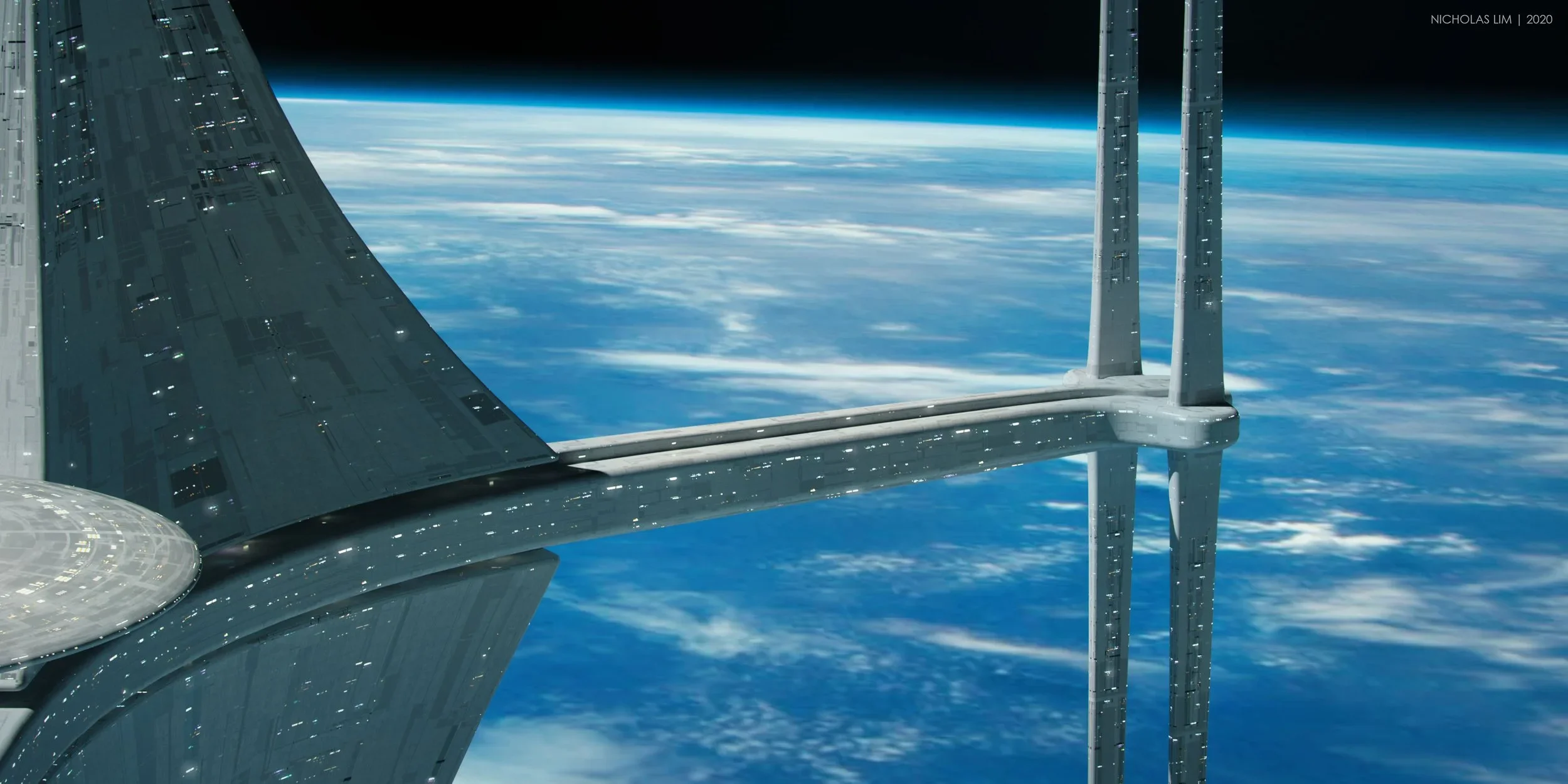Building A “Floating City” In Low Earth Orbit
Paragon Station is a concept design for a futuristic mega-station in low Earth orbit (LEO).
Image credit: Nicholas Lim / Magnovation Design Company
From concept art to credible programme, a business-first look at mega-stations in LEO
Concept images of vast orbital complexes are compelling, but investors and policymakers need a grounded brief: what a station of that scale would actually do, how you would design and assemble it, why fusion power and artificial gravity are not plug-and-play, and what makes the timelines and budgets believable. The critical thinking process needs to be staged: replace the International Space Station (ISS) this decade with commercial successors, prove the hard parts (rotation, large-scale assembly) with dedicated demonstrators in the 2030s–2040s, and only then aggregate the pieces into a multi-purpose “floating city” over a 50–75-year horizon. That is an aggressive plan, but it maps to real programmes, real gaps, and a real market pull, as the market itself grows.
At the scale depicted—a multi-module complex with docks, yards, labs and neighbourhood-like habitats—utility is diversified by design. The station functions as a workplace (factories in microgravity, medical labs, cleanrooms, test bays), a scientific campus (astronomy, Earth observation, deep-space mission operations, education), a spaceport for tugs and crew vehicles heading to the Moon, Mars and selected asteroids, and a hospitality district (hotels, leisure centres) when tourism grows beyond boutique levels. In short: a city’s worth of tenants, not a single mission. The business logic is familiar from ports and airports—mix high-margin traffic (crew transfer, urgent payloads) with steady industrial tenants (manufacturing lines, supply-chain, logistics, servicing depots) and public missions (labs, observatories) to smooth revenue cycles.
A very large object in low Earth orbit (LEO) behaves like a very large ship in a slow headwind: atmospheric drag never goes to zero. The ISS, at roughly 400 km altitude, requires regular reboosts—engine firings that keep it in its lane, timed around visiting shuttles. Any complex an order of magnitude larger in cross-section will need a methodical approach to drag compensation, rendezvous timing and traffic sequencing. Expect a permanent line item for propulsion and guidance, and plan docking events around reboost schedules as the ISS has done for years.
Power and artificial gravity
Concept art often shows “fusion-powered” stations. The reality is that there is no fusion reactor ready for launch, and even on the ground the flagship projects are decades from commercial electricity. ITER’s revised schedule points to staged physics operations starting in the 2030s, not grid power, while the National Ignition Facility’s milestone shots in 2022 were scientific breakthroughs, not plant-level energy gain. For a mega-station in the next 50–75 years, that implies large solar arrays with batteries/fuel cells, potentially augmented later by beamed power from dedicated platforms. Fusion remains a long-term R&D lane, not a design basis.
Rotation is the only realistic way to create artificial gravity in orbit, mitigating bone and muscle loss and easing long-stay operations. But a rotating complex is a control-systems problem, a human-factors problem, and a logistics problem. Crews must adapt to Coriolis effects and spin rates; the structure must isolate rotating and non-rotating zones; docking has to happen safely at the interface. NASA and academic studies propose exactly what’s needed—a rotating-station technology demonstrator to gather data on dynamics, control, docking and human tolerance before anyone commits to a city-scale ring. In other words, build a pilot line for gravity.
From one-off art to buildable system: the assembly plan
There is only one proven way to create something this large in orbit: modular assembly over many flights with robotics, EVA/IVA procedures and tight configuration control. The ISS remains the benchmark—roughly 1,000 m³ of pressurised volume, ~410 tonnes mass, ~100 kW class power—assembled over more than 40 missions across a decade, and continuously upgraded. A mega-station multiplies that by several factors, which is why a phased approach is not optional: commercial LEO stations first, larger hubs next, rotation demo in parallel, then progressive aggregation into a district-scale complex.
NASA’s Commercial LEO Destinations (CLD) programme is the practical bridge between ISS and a market of free-flying stations. Awards to teams including Blue Origin, Nanoracks-Voyager, Northrop Grumman and others underwrite designs for privately owned, multi-tenant platforms aimed at research, manufacturing, tourism and government services. Treat these as the seed ports and business models: standards for interfaces, logistics chains for cargo and crew, ground systems for operations, and the service contracts that turn orbital lab time into revenue.
Functions that justify the scale
A mega-station earns its keep the way a diversified campus does on the ground.
In-space manufacturing moves from experiments to repeatable production: fibre and crystal growth, bio-manufacturing and organoids (miniature organs), precision optics, and high-reliability components whose quality improves in microgravity. These start as tenant modules, scaling to dedicated halls if unit economics hold.
Servicing, assembly and yards become routine. With docks, cranes and robotic arms, you can refuel satellites and tugs, swap modules, capture and de-orbit debris, and assemble large structures that can’t be launched in one piece. GEO tugs and lunar transfer stages cycle through for maintenance.
Science and observation benefit from location and cadence: astronomy platforms mounted on rigid booms or free-flyers serviced from the station, and Earth-observation instruments whose data feeds climate, agriculture and insurance markets.
Hospitality and training become a line of business once access prices and flight cadence drop; space tourism is a niche at first, but a station that looks like a small city can support hotels, leisure spaces, and long-stay crews with “normal” routines.
A true spaceport emerges: crew and cargo go “upstairs” to the station, then out to the Moon, Mars and selected asteroids on staged vehicles—the same hub-and-spoke logic that made air travel efficient.
None of this requires fantastic imagination; it requires throughput and standards. The mega-station is the intermodal hub where microgravity manufacturing, biotech, science, tourism and deep-space logistics share power, life support and safety systems.
A closer view of the conceptual Paragon Station.
Image credit: Nicholas Lim / Magnovation Design Company
Critical factors: safety, medical autonomy, power, and utilities
A city-scale station implies hospital-grade medicine, not just first aid. Radiation shielding (water walls, modular mass), redundant life support, fire detection and compartmentalisation, med-evac doctrines and on-station surgical capability all need to be designed, trained and audited. Artificial gravity (even partial) reduces physiological risk but adds complexity; non-rotating safe-harbour modules and spin-up/down protocols become part of normal ops. Human-centred design from the commercial habitat programmes—privacy, acoustic comfort, circadian lighting, meaningful workspaces—should be treated as productivity infrastructure, not soft add-ons. (NASA’s human-research work on gravity countermeasures and operational adaptation is the best guide to what must be demonstrated long before population scales.)
With solar as the baseline, power architecture scales like a micro-utility i.e. a self-contained power and thermal system: multi-megawatt arrays, batteries/fuel cells for eclipse, DC distribution with sectionalisation and fault isolation, and the thermal plant (radiators, pumps) to reject heat. Most of this is solvable at scale with today’s engineering; the right risks to retire are maintenance at height (robotics rather than crew for array and radiator work), common spares across tenants, and load management when industrial users and visiting vehicles peak at once. Fusion can be revisited only when terrestrial systems prove net electrical output with full balance-of-plant—valuable to track, unwise to rely on.
Budgets and financing: orders of magnitude that can be defended
Nobody can cost a concept image. We can, however, frame order-of-magnitude numbers from public programmes. ISS-class build-outs required dozens of launches and international budgets across many years; successor stations under CLD will land in the multi-billion range per platform, rising with size and services. A rotating “district-scale” complex will push into the tens of billions over a decade or more, plus launch and sustainment. That is not outlandish for infrastructure on this scale—it is in line with airports, subsea cables and offshore energy—but it only becomes financeable when risk retires in sequence: first with commercial stations that show uptime and utilisation, then with a rotation demonstrator (a small, purpose-built test spacecraft that spins to create artificial gravity) that proves dynamics and human adaptation, then with yards and factories that generate revenue.
What does a credible 50–75-year arc look like?
2025–2035: commercial LEO stations enter service as the ISS concludes, validating multi-tenant operations, tourist throughput, biolabs, and early manufacturing. Watch CLD milestones, module deliveries and on-orbit service metrics.
2035–2045: larger hubs are assembled; a rotating-station technology demonstrator flies to gather data on spin rates, docking, control and human tolerance; assembly robotics scale beyond ISS heritage. These are programme decisions, not renderings.
Post-2045: aggregation into a district-scale complex begins if the economics and safety cases close. Fusion remains a watch item; solar and beamed power dominate. Over time, the complex adds neighbourhoods and yards the way cities add terminals and piers.
Signals to track are prosaic but telling: published availability figures for early commercial stations; standard interfaces that let third-party modules plug in; a funded rotating demonstrator with clear test cards; and service companies that show revenue from refuel/repair/assembly rather than one-off missions.
When it comes to governance and risk, existing regulatory playbooks can be updated to make them applicable. Combine the logic of undersea cables (international corridors and repair rights), airports (safety zones, traffic management) and nuclear-grade quality (traceability, inspection, liability) and you have a frame for licensing a mega-station and its approaches. Underwriters will care about availability metrics, maintenance regimes (including on-orbit section replacement), and debris interaction controls—exactly the focus of recent station studies and proposed demonstrators.
Why a mega-station becomes economically inevitable
If launch continues to get cheaper and more frequent, one-off missions look increasingly out of place. A large station is how you turn access into cadence: the place where science, industry, tourism and deep-space logistics share utilities, safety and standards. Power comes from sunlight, gravity is engineered, and assembly is a campaign, not a single event. The result is not a one-off project but a market—a busy, mixed-use hub that feels less like a spaceship and more like a port city whose tenants happen to wear flight suits. The route from here to there is demanding but navigable: commercial stations now, demonstrators next, aggregation after. On a 50–75-year view, that is not science fiction; it is what disciplined infrastructure looks like in orbit.

